A long winter is not for sissies. If you are a veteran of many northern winters, you probably already practice most of the tips I’m going to share below. But if you are new to the tribe of hardy plants and hardy souls, here are some ways to beat cabin fever.
1Light TherapyIn the land of the low-lying sun, Seasonal Affective Disorder is a real problem. If winter has you so down you feel like you might never get up, consult a health care professional. Light therapy is usually part of the recommended treatment. The lightboxes used for treatment used to be big, bulky affairs, but now they are so lightweight and portable that you can slip one in your briefcase and take it to work. I use Carex Day-Light Classic Plus Light Therapy Device and it helps me keep my spirits up.
2Snail Mail Therapy If you work at home, the arrival of the postal mail can seem like the highlight of your day, and it helps if you arrange for something good to show up in your mailbox. I confess that in the past I filled out those one-free-issue cards for magazines I had no intention of subscribing to, just so I would get something different in the mail. A better idea would be to subscribe to Northern Gardener, so you will get gardening advice targeted to our challenging conditions all year round. Also keep your eye out for a regional gardening magazine. For me, it’s Upstate Gardeners’ Journal, which also has a digital edition. If you’ve already got that nailed, look here for more fine gardening magazines and here for more garden magazine reviews.
If you work at home, the arrival of the postal mail can seem like the highlight of your day, and it helps if you arrange for something good to show up in your mailbox. I confess that in the past I filled out those one-free-issue cards for magazines I had no intention of subscribing to, just so I would get something different in the mail. A better idea would be to subscribe to Northern Gardener, so you will get gardening advice targeted to our challenging conditions all year round. Also keep your eye out for a regional gardening magazine. For me, it’s Upstate Gardeners’ Journal, which also has a digital edition. If you’ve already got that nailed, look here for more fine gardening magazines and here for more garden magazine reviews.
3Retail therapyEven better than mail delivery is a package brought to your doorstep. If you have some holiday gift money waiting to be spent, consider buying a gardening book specifically aimed at our climate. The University of Minnesota Press updated and revised their three-volume series on growing in cold climates: Growing Perennials in Cold Climates
(my review of first edition), Growing Shrubs and Small Trees in Cold Climates
(my review here), and Growing Roses in Cold Climates
(my review on two rose books). If your winter garden is no garden at all, Prairie Winterscape: Creative Gardening for the Forgotten Season
will inspire you, as it inspired me. And since the gardening season is defined by when frost ends in the spring and when it begins in the fall, maybe you need to consult A Gardener’s Guide to Frost: Outwit the Weather and Extend the Spring and Fall Seasons
. I found the book very helpful. Or maybe you’ve got enough books. How about some garden shoes or other accessories?
4
Seed Therapy Technically, this comes under numbers two and three, but poring over seed catalogs and obsessing over seed purchases is such a time honored way for a gardener to while away the winter that I felt it deserved a place of its own on this list. I have listings for cold climate seed merchants, plus posts on seeds for cold climates and online seed-starting info from the seeds and seed starting category of posts. We even have several posts reviewing catalogs. And for the true obsessives, see my series on using spreadsheets in garden planning.
5Bird Therapy
Snow is good. It protects the crowns of plants from from fluctuating temperatures and the bitterest cold. It reflects what little light we get from the sun, which is often obscured by clouds. But snow is a great equalizer. It hides color and flattens shape, and often inhibits movement in the landscape. When you set up one or more bird feeders outside a window, you bring color, shape, and movement back into the landscape.
But birds are more than something to look at. You can’t watch them for long before wanting to know more about them: What kind of bird is that? Why do they come at certain times of day? How do they know to take turns? There are plenty of books on bird feeding, so I will just give you one piece of advice. Don’t buy the cheapest seed mix you can find. Buy black oil sunflower seed. If the birds don’t ignore the cheap mix altogether, they will pick the sunflower seed out of it and just make a mess of the rest. They will make a mess, anyway, so here’s a second piece of advice: Don’t hang the bird feeder over an area where you don’t want bird poop and seed shells. Wait–make that three pieces of advice: if you know a bear frequents your neighborhood, better think twice about putting out bird seed. Bears love bird seed.
6Online Garden Therapy Since you are at this moment reading a blog, I concede this is a bit like preaching to the choir, but the internet is a wonderful way to explore the world of gardening when the garden outdoors is less than hospitable. There is a fine–though not comprehensive–selection of cold climate blogs in my garden blog directory, so you can virtually visit gardeners in climates similar to your own and pick up some good ideas–or sympathize, as the case may be. If you want to get a taste for what’s blooming around the world, there’s no better place to start than by perusing the posts listed on Garden Bloggers’ Bloom Day, hosted by Carol at May Dreams Gardens. If you want to get a little more involved and maybe a little more organized, there are several gardening communities online, such as Folia, GardenTenders, GardenStew, and The Mulch
–kind of like Facebook for gardening. Check them all out to see if one floats your boat. If you are isolated or lonely, they can be an effective way to make new friends without leaving home.
7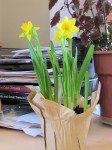 Cut Flower Therapy I used to think cut flowers were only for rich people, but now I know that cut flowers are a frugal luxury. In terms of bang-for-the-buck, they are a more potent mood lifter than–well, just about anything I can think of. Take a lesson from Debra Prinzing, who challenged herself to come up with a new floral arrangement made with locally-bought and -found flowers every week for a year, to tie in with her book, Slow Flowers: Four Seasons of Locally Grown Bouquets from the Garden, Meadow and Farm
Cut Flower Therapy I used to think cut flowers were only for rich people, but now I know that cut flowers are a frugal luxury. In terms of bang-for-the-buck, they are a more potent mood lifter than–well, just about anything I can think of. Take a lesson from Debra Prinzing, who challenged herself to come up with a new floral arrangement made with locally-bought and -found flowers every week for a year, to tie in with her book, Slow Flowers: Four Seasons of Locally Grown Bouquets from the Garden, Meadow and Farm. Her off-white arrangement for week one is elegant but doable, even if you have a wait a few more weeks here for pussy willows to show up in the market. If buying cut flowers just seems too wasteful to you, consider a pot of forced flowers, such as these narcissus pictured above that jumped into my grocery cart last week. Or, see number eight.
8
Forced Flower Therapy Forcing hyacinths is one of my favorite ways to garden in winter. If you use a hyacinth glass you can see the roots forming. And unlike many blooming houseplants, the hyacinth changes almost every day. If you didn’t have the foresight to purchase bulbs in October (Mark it on your calendar now, for next October) and start them chilling, you may find already forced bulbs in the grocery store now. Aldi, in particular, seems to sell them for a reasonable price–less expensive than buying the hyacinth vases by themselves! Of course, you can also grow amaryllis or my new fave, lily-of-the-valley. There’s lots more flowers you can force besides the ones I’ve tried. Read Bulb Forcing for Beginners and the Seriously Smitten (my review here) to find out more.
9 Outdoor Exercise Therapy Grab every chance you get this winter to get some sunshine. Unless the weather service has issued a wind-chill or extreme cold warning, don’t let cold be your excuse. No time? Use your lunch break. Icy surfaces? Get some Yaktrax
Outdoor Exercise Therapy Grab every chance you get this winter to get some sunshine. Unless the weather service has issued a wind-chill or extreme cold warning, don’t let cold be your excuse. No time? Use your lunch break. Icy surfaces? Get some Yaktrax (pictured at right). Snow too deep? Snowshoes!
There’s no sense being in denial–it’s cold in winter and you need to gradually build up a collection of clothing and equipment to deal with it. If you have a couple of hours to spare, get yourself to the nearest botanical garden or local park, as Gail from Clay and Limestone suggests. There are certain to be cleared walkways there and plants and wildlife that you don’t see in your own backyard. The change of scenery will do you good.
10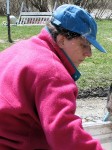 Outside Gardening Therapy Sometime in the middle of winter, usually in January, we have a thaw. Some mud season pruning chores can be done any time you feel like going out there, which is usually during a thaw. On rare occasions the thaw is so extensive that you can actually pull weeds. But mostly you will be limited to pruning and trail maintenance. Frances of Fairegarden, who does not live in a cold climate and thus often gardens in winter, nevertheless knows the appropriate attire for such an occasion: “boots, waterproof pants with long johns, a turtleneck, flannel shirt, hooded sweatshirt, waterproof jacket, knit hat and always gloves.” You will be standing and kneeling in snow, and the wind may be brisk. You can always peel off a layer if you get too hot, and it’s much more pleasant than treating frostbite. But actually gardening outside is the creme de la creme of cabin fever therapies, so be sure to take advantage of it if the opportunity comes your way. It is highly effective.
Outside Gardening Therapy Sometime in the middle of winter, usually in January, we have a thaw. Some mud season pruning chores can be done any time you feel like going out there, which is usually during a thaw. On rare occasions the thaw is so extensive that you can actually pull weeds. But mostly you will be limited to pruning and trail maintenance. Frances of Fairegarden, who does not live in a cold climate and thus often gardens in winter, nevertheless knows the appropriate attire for such an occasion: “boots, waterproof pants with long johns, a turtleneck, flannel shirt, hooded sweatshirt, waterproof jacket, knit hat and always gloves.” You will be standing and kneeling in snow, and the wind may be brisk. You can always peel off a layer if you get too hot, and it’s much more pleasant than treating frostbite. But actually gardening outside is the creme de la creme of cabin fever therapies, so be sure to take advantage of it if the opportunity comes your way. It is highly effective.
Those are my best remedies for cabin fever. Do you have any that I missed? Did you pick up a good tip? Let me know in the comments.
Links to Amazon.com are affiliate links, meaning I will earn a small commission if you purchase something after clicking through.

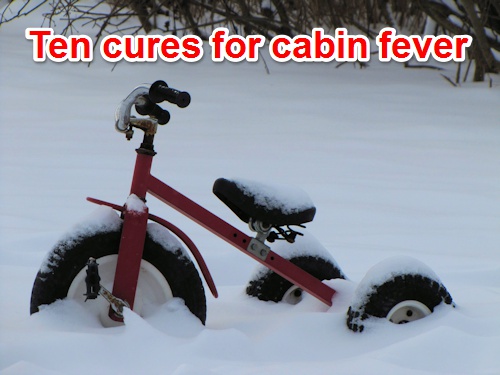


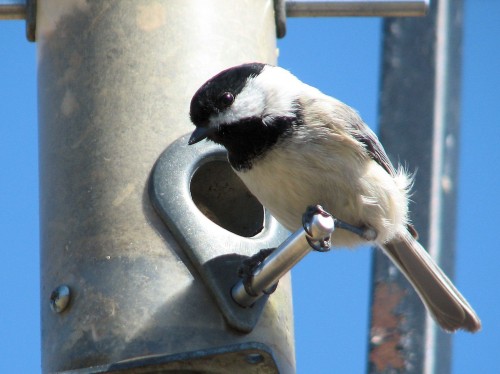
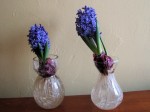



Right on the money there Jim. Just because it’s winter does not mean that you cant grow indoors. LED grow lights are now inexpensive to install and operate and give you the opportunity to do all the growing you have room for indoors.
A great list of tips! I plan to come back soon and check out your links, looking especially for new websites and garden books.
I would like to add a couple more winter therapies. First, check out all the garden resources at your local library. Ours is part of a 4 county network that lets you search across many libraries seeking the books you want, and put in a request for any number of items. They’re delivered at no charge to your local library, and the system emails to let you know when they’re in. Going to town to pick up books is a nice break in winter too, and you can check out what’s recently been turned in on the waiting-to-be-shelved cart, read the community announcements on the bulletin boards, and browse the fun magazines that are too expensive (or too trashy) for you to subscribe to. If they provided good coffee, the library would be just about perfect!
Second tip: raise chickens. It’s fun to bring them treats such as old lettuce or bread bits, and give them pep talks about egg-laying. They coo back at me, especially when they think more treats are in the works. Our chickens are troopers in the winter, wanting to go outside any time the temps are in the 20’s or warmer, as long as they have some snowless walking space. If it’s not snowing steadily, I spread some cardboard, hay or old wood chips to give them an outdoor space. They like a break from being “cooped up”. If a little chicken can make do in the winter, who am I to complain?
I have a regular library day when I also do all my village errands, and we also keep chickens, but I hadn’t considered either of those cabin fever cures–but they certainly are! Thanks for adding them to the list!
I live in west colorado and the weather has been just morbid! Teen for highs and it had gotten as cold as -13 at night. Some of your tips have indeed inspired me to try a new angle in my gardening craving! I have cats. Any tips for safe indoor gardens? Maybe pet frendly? Please let me know . Andy
Hi Kathy, thanks for mentioning floral arranging as a way to cheer up oneself during January!!!
I like fruit and vegetable gardening, and I’ve just learned about winter sowing. I’m excited to try it out this year, so that has helped a lot with my winter blues!
http://inthegardenonline.com/main/2013/01/let-the-wintersowing-begin/#comments
These are all great suggestions and great links. I am using this season to have cataract surgery done. You can’t do any gardening (or dusty housework) for at least two weeks after each eye is done. A month of gardening forbidden in good weather? No!
One at a time and wear a patch?
The garden pirate. Argh!
I think you are smart to schedule elective surgery in the off season. Wishing you a speedy recovery!
Thanks for the tip on just buying sunflower seeds. We all get involved in bird watching here. Even my dog! We’re lucky enough to abut a park with a pond that attracts many migrating birds. Also have a cardinal couple that adds color to the drabness.
Growing salad greens indoors under grow lights sure helps pass the long dark Alaska winters and the color and light are an added bonus. This winter I am growing some dwarf tomatoes inside too. If you have the lights for starting your summer garden plants – why not use them all winter ? http://chateau-listeur.blogspot.com/2013/01/winter-tomatoes-in-wasilla.html
Bird therapy, yes! I actually have many CDs of birdsong that were recorded from all parts of the world. I LOVE these things!
Also plant catalogs. If I can’t be out there in reality, my imagination is the next best thing.
An excellent winter survival guide. Thanks! It was actually mild enough today to go out and give haircuts to the clematis and honeysuckle.
Along with some of these, I bring in herbs and put them under grow lights…I also grow some lettuce too.
Every time I have brought herbs like parsely and basil indoors for the winter, they have gotten aphids and I had to get rid of them. But I grew them as houseplants on a windowsill. Maybe I need to try again with lights. And perhaps starting from seed works better?
Thank you!
I really needed to read this. The garden is resting, the shop is devoid of customers, and I’m certainly feeling the January blues.
This post reminded me to be cheerful!
Thanks for the shout-out for Northern Gardener and the new digital edition, Kathy! I like your list, and have tried all of them over my many years in Minnesota. But you missed one of my favorites, which is to dig into the freezer for some the little packets of homemade pesto that I set aside in August and September. It’s like summer on a plate!
Mary, I use that pesto trick, too! Actually there are lots of foods that can transport you to summer. There are a lot of ways to put on the pounds, too. Maybe it’s just as well I forgot to put it on the list.
Stay warm and cozy while dreaming of spring, Kathy! Here’s to a new seed catalog arriving every day!
Kathy, these are wonderful tips for the winter tired. I used so many of them this year. I don’t know what I would do without my cut flowers and forced bulbs. I also bought a light therapy kit for our family. We set it up in the spare bedroom. It’s good to know there’s a spot on the Internet where you can read more tips. Thank you so much for this and for linking to my article for Fiskars.~~Dee
Great list! I am partial to number 6. I would also suggest using winter to do any indoor project that doesn’t require outside work as well. You just keep repeating to yourself “I am doing this now so I don’t have to give up gardening time in the spring to do it.”
What a great post and chock full of links to keep anyone with cabin fever occupied and distracted from inclement weather. We have rain during our winter months and I often feel stuck inside when I would rather be out~I put on my rain gear and head for a walk! It’s too muddy in a clay garden to be walking on the beds and digging. Thank you for including me in this stellar lineup! xogail
Although I don’t often have reason to have cabin fever, at least not due to the weather, I appreciate this post as a wonderful source for links to all sorts of interesting things. Thanks Kathy!
What a delightful list of therapies to help a gardener get through the winter, Kathy, but I have to admit that my favorite is that last one. As long as the ground is not frozen solid, and it has been some years since that has happened here in my Tennessee garden, it is deemed to be perfectly acceptable to gear up, as mentioned above, and go on out there. If you can bend over with all of those clothes on, that is. Thanks for the linkage, my friend!